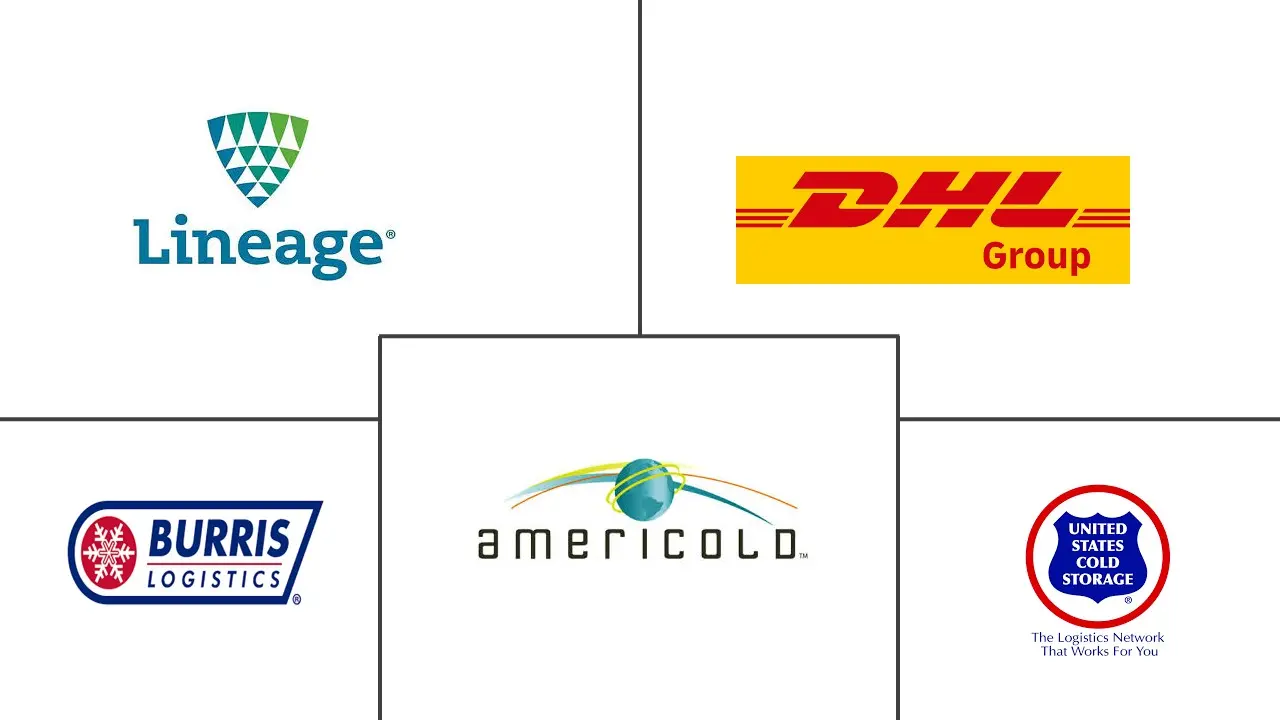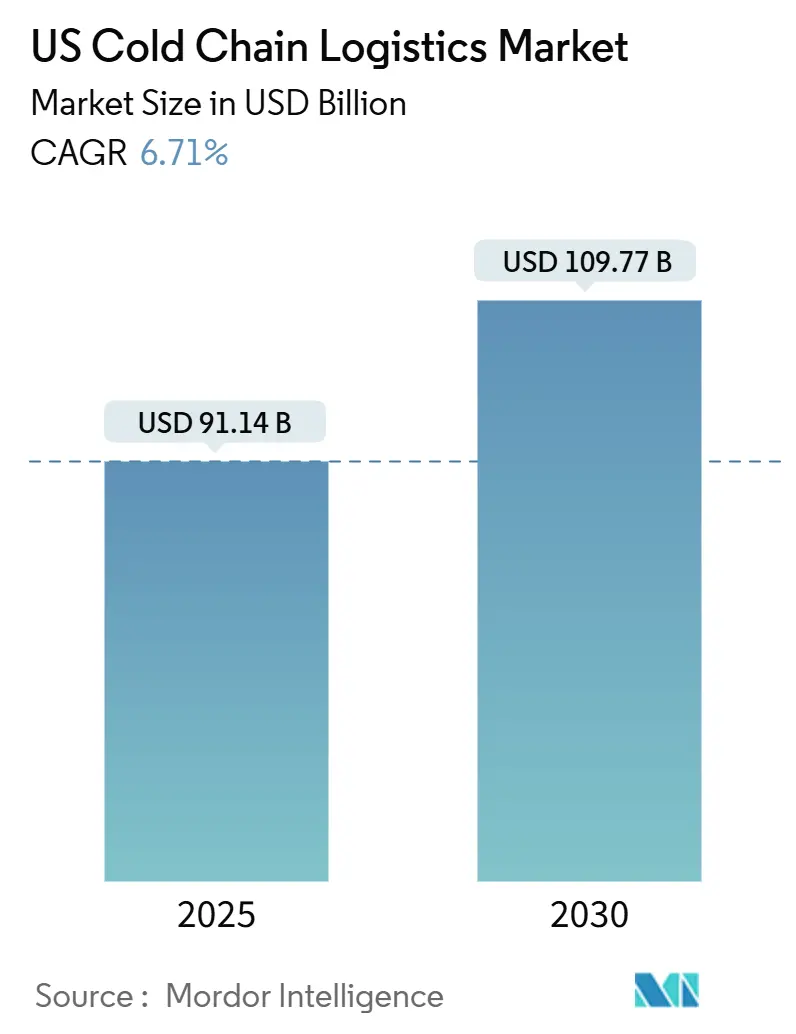
US Cold Chain Logistics Market Analysis by Mordor Intelligence
The US Cold Chain Logistics Market size is estimated at USD 91.14 billion in 2025, and is expected to reach USD 109.77 billion by 2030, at a CAGR of 6.71% during the forecast period (2025-2030).
Growth gathers momentum from the surge in temperature-sensitive pharmaceuticals, rapid e-grocery adoption that shortens delivery windows, and sustained investment in energy-efficient warehousing that lowers operating costs even as capacity expands. Large national providers absorb regional specialists to spread the cost of IoT monitoring and compliance technology across bigger networks, while smaller firms carve out niches in ultra-low-temperature storage and urban micro-fulfillment. Regional dynamics shape strategy: the Southeast keeps its lead on the back of dense port traffic, yet the Southwest posts the fastest gains thanks to biopharma manufacturing and cross-border produce flows. Deep-frozen capacity below –70 °C moves from a niche to a necessity as mRNA vaccines and cell-based therapies progress through pipelines, prompting facility retrofits that prioritize redundant power and vacuum-insulated panels. At the same time, land scarcity near major ports encourages inland hub-and-spoke models that balance real-estate cost, power availability, and service reliability.
Key Report Takeaways
- By service type, Refrigerated Storage dominated with 57 % market share in 2024, while Air Transportation is projected to post the fastest 14 % CAGR to 2030.
- By temperature range, Frozen (-18 °C to 0 °C) led with a 61 % share in 2024; Deep-Frozen/Ultra-Low (below –20 °C) is forecast to expand at a 13 % CAGR through 2030.
- By application, Meat & Poultry commanded a 22 % share in 2024, whereas Vaccines & Clinical Trial Materials are advancing at a 16 % CAGR to 2030.
- By region, the Southeast held the largest 34 % US cold chain logistics market share in 2024, while the Southwest is growing fastest with a forecast 11 % CAGR through 2030.
US Cold Chain Logistics Market Trends and Insights
Drivers Impact Analysis
| Driver | (~) % Impact on CAGR Forecast | Geographic Relevance | Impact Timeline |
|---|---|---|---|
| E-grocery Penetration Fueling Sub-Zero Last-Mile Capacity Across U.S. Metros | +1.8% | Nationwide, first movers in Northeast & West Coast | Short term (≤ 2 yrs) |
| Biologics Pipeline Growth in Boston Raleigh Corridor Elevating Ultra-Low-Temp Demand | +2.1% | Boston-Raleigh corridor, spreading to other biotech hubs | Medium term (3-4 yrs) |
| California SB 1383 Food-Waste Mandate Accelerating Produce-Focused Cold Storage | +0.9% | California, ripple to progressive states | Short term (≤ 2 yrs) |
| QSR Meal-Kit Partnerships Driving Multi-Temp Cross-Dock Hubs in the Midwest | +0.7% | Midwest, national spillover | Medium term (3-4 yrs) |
| Asian Seafood FDI Establishing Gulf-Coast Import Nodes | +0.4% | Gulf-Coast ports, national distribution reach | Medium term (3-4 yrs) |
| Inflation Reduction Act Tax Credits Boosting Energy-Efficient Refrigerated Warehouses | +0.8% | Nationwide, highest take-up where state incentives align | Short term (≤ 2 yrs) |
| Source: Mordor Intelligence | |||
E-grocery Penetration Fueling Sub-Zero Last-Mile Capacity Across U.S. Metros
Online grocery sales already represent a sizeable share of total grocery transactions in large US cities, pushing operators to retrofit or build micro-fulfillment centers within roughly ten miles of consumers. Because three-temperature routing is now routine—frozen, chilled, and ambient on a single truck—carriers adopt electric refrigerated vans that meet emerging zero-emission mandates in California and the Northeast. Many urban facilities consume over 40 % more energy than single-zone stores, prompting rapid adoption of heat-recovery refrigeration that lowers utility spend even as throughput rises. A fresh implication is that delivery fees increasingly reflect temperature complexity rather than distance alone, nudging retailers toward dynamic pricing models that allocate costs more accurately to high-maintenance loads.
Biologics Pipeline Growth in Boston Raleigh Corridor Elevating Ultra-Low-Temp Demand
More than 1,000 advanced therapies in clinical stages now require storage below -70 °C, spurring a surge of investment in vacuum-insulated panels, redundant power, and phase-change materials along the Boston-to-Raleigh life-sciences corridor. Hospital pharmacies, once peripheral to wholesale distribution, are retrofitting small-footprint cryogenic rooms to meet point-of-care handling rules, effectively embedding miniature cold stores inside clinical campuses. Airlines and forwarders mirror this shift by equipping cargo hold positions with real-time temperature telemetry, turning aircraft into de facto flying warehouses. This interplay tightens collaboration between shippers and carriers, reducing spoilage risk yet simultaneously raising the bar for data integrity across the entire US cold chain logistics market.
California SB 1383 Food-Waste Mandate Accelerating Produce-Focused Cold Storage
The 75 % organic-waste reduction requirement in California by 2025 has forced retailers to prioritize ripening rooms and controlled-atmosphere storage capable of extending produce life by up to twelve days[1]CalRecycle Staff, “Short-Lived Climate Pollutants: Organic Waste Methane Emissions Reductions,” California Department of Resources Recycling and Recovery, calrecycle.ca.gov. Operators who once viewed shelf-life tools as optional now treat them as compliance essentials, redirecting capital from traditional expansions toward specialized sensor suites that measure ethylene levels in real time. Notably, penalty risks of as much as USD 10,000 per day motivate smaller distributors to partner with third-party specialists rather than shoulder technology costs alone. This regulatory catalyst places California at the forefront of waste-avoidance innovation, a position likely to inform rulemaking in other states over the next three years.
QSR Meal-Kit Partnerships Driving Multi-Temp Cross-Dock Hubs in the Midwest
Quick-service restaurants (QSRs) teaming with meal-kit brands have spawned a new demand node: cross-docks that can stage frozen entrées, chilled produce, and ambient condiments simultaneously. Most projects cluster in the Midwest, where central geography trims outbound miles to both coasts and proximity to protein producers shortens inbound legs. Inside these hubs, automated shuttle systems move totes between temperature zones at speeds previously seen only in e-commerce apparel. One immediate effect is tighter order-to-ship windows—often under two hours—which persuades QSRs to pre-position inventory during off-peak utility periods to curb electricity surcharges.
Restraints Impact Analysis
| Restraint | (~) % Impact on CAGR Forecast | Geographic Relevance | Impact Timeline |
|---|---|---|---|
| Industrial Land Scarcity with 2 MW+ Power Near Tier-1 Ports | -1.2% | Port metros (LA, NY/NJ, Seattle) | Long term (≥ 5 yrs) |
| Specialized Reefer Driver Shortage Inflating Haulage Costs | -1.4% | Nationwide, acute in Northeast & West | Medium term (3-4 yrs) |
| Grid Reliability Issues Raising Backup-Power CAPEX (TX & CA) | -0.8% | Texas & California | Medium term (3-4 yrs) |
| OSHA Ammonia Compliance Costs for Aging Facilities | -0.3% | Nationwide, heavier on pre-2010 sites | Short term (≤ 2 yrs) |
| Source: Mordor Intelligence | |||
Industrial Land Scarcity with 2 MW+ Power Near Tier-1 Ports
Vacancy for power-ready parcels within five miles of major ports such as Los Angeles and New York now sits below 2 %, propelling land prices 78 % higher since 2024. Developers increasingly pivot toward inland “hub-and-spoke” models, placing high-cube warehouses where land and power are abundant while relying on smaller cross-dock units at the port gates. The re-routing adds a line-haul leg yet allows higher automation levels, offsetting mileage costs through labor savings. Interestingly, some shippers accept one extra day of transit in exchange for capacity guarantees, signaling that reliability may trump speed when port real estate becomes the limiting factor.
Specialized Reefer Driver Shortage Inflating Haulage Costs
The pool of drivers certified to handle GDP-compliant pharmaceutical freight shrank 23 % over the past year despite wage premiums that exceed 15 % versus standard reefer work. Carriers respond by adopting platooning and remote temperature telemetry that reduce manual record-keeping, enabling experienced drivers to cover more revenue miles. Simultaneously, training schools accelerate curricula focused on digital compliance, causing newly minted operators to enter the market already fluent in IoT dashboards. As technology shouldering grows, compensation strategies begin rewarding cold-chain knowledge almost as much as time behind the wheel, a subtle shift that could elevate professional status within the broader trucking community.
Segment Analysis
By Service Type: Storage Dominates While Air Soars
Refrigerated storage held 57 % market share in 2024, underscoring its foundational role in the overall US cold chain logistics market size. Consolidation favors public warehousing because larger footprints spread compliance and energy-efficiency investments across more racked pallets, driving per-unit costs lower than those achievable by captive facilities. A concurrent trend sees big-box grocers outsourcing overflow volume during promotion peaks, hinting that flexible capacity will remain a bargaining chip even for vertically integrated chains. Meanwhile, operators retrofit legacy buildings with automated shuttle systems that raise throughput without expanding walls, a tactic that effectively secures new revenue from existing real estate.
Air transportation is projected to log a 14 % CAGR through 2030, the fastest of any service type, as high-value biologics justify premium carriage and strict time-temperature margins. Airlines collaborate with freight forwarders to create GDP-validated lanes that guarantee sub-eight-hour tarmac exposure, effectively turning airports into micro-cold stores with plug-in freezers. Over-the-road trucking still moves the bulk of tonnage, yet rising driver shortages prompt shippers to explore rail-road combos where long-haul reefer boxes travel by train before final delivery by truck. This hybrid model signals that modal diversification may become the new normal as service reliability competes neck-and-neck with lead time.
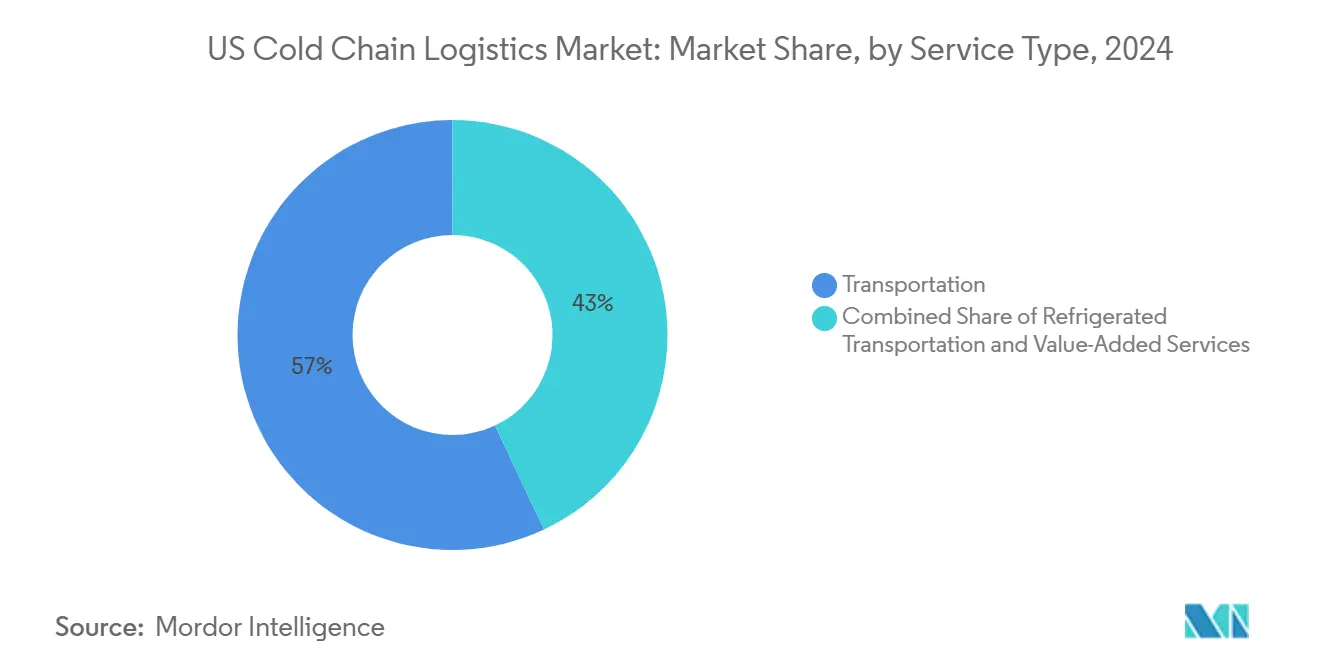
Note: Segment shares of all individual segments available upon report purchase
By Temperature Type: Deep-Frozen Segment Accelerates
Frozen products between -18 °C and 0 °C account for 61 % of the US cold chain logistics market share in 2024, but growth now tilts toward deep-frozen and ultra-low settings below -20 °C, which are forecast to advance at an 13 % CAGR through 2030. Operators shift capital to cascade refrigeration and vacuum-insulated panel technology, shrinking energy loss even at extreme temperatures. That investment unlocks downstream benefits: better thermal hold mitigates risk during truck breakdowns, lowering insurance premiums and raising shipper confidence. Parallel to these moves, some warehouses convert idle dock doors into cryogenic chambers, turning sunk assets into revenue streams without green-field builds.
Chilled storage between 0 °C and 5 °C outpaces the market average as fresh meal kits, bagged salads, and functional beverages flourish. Route-optimization software that factors both travel time and compressor cycling cuts fuel burn and shrinks carbon footprints, aligning with retailer sustainability pledges. The ambient segment, though uncooled, increasingly integrates with multi-temp campuses that share labor and automation resources, creating efficiencies that single-zone sheds cannot match. Taken together, temperature versatility evolves from a technical specification into a core commercial differentiator inside the US cold chain logistics industry.
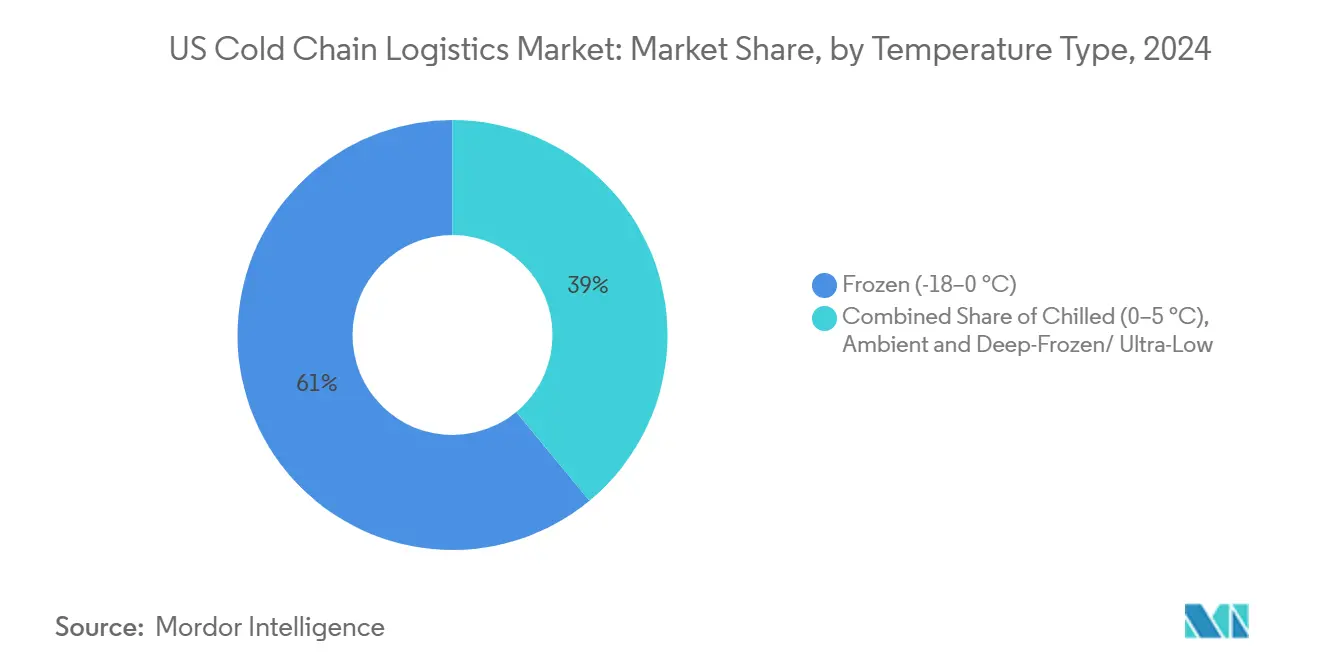
Note: Segment shares of all individual segments available upon report purchase
By Application: Pharmaceuticals Challenge Food Dominance
Meat & poultry retained 22 % of US cold chain logistics market share in 2024, reflecting Americans’ enduring consumption preferences. Innovations such as case-ready packaging and high-oxygen modified-atmosphere trays extend shelf life, which in turn weakens the need for buffer inventory and releases space for growth categories. With bird flu episodes periodically tightening supply, processors value storage partners who can flex space on short notice, reinforcing the importance of contractual agility. As a by-product, system-wide waste falls, indirectly easing pressure on California-style waste regulations.
Vaccines and clinical-trial materials lead growth at a 16 % CAGR between 2025 and 2030, demonstrating how small-volume, high-value cargo can reorient network design. Carriers deploy smart boxes with GPS and temperature sensors, enabling custody chains compliant with FDA Good Distribution Practice rules[2]U.S. Food and Drug Administration Staff, “Good Distribution Practice Guidance for Industry,” U.S. Food and Drug Administration, fda.gov. Hospitals leverage these same boxes to reposition specialty drugs among campuses overnight, reducing patient wait times and elevating care standards. Though representing less cubic footage than frozen pizza, pharmaceutical cargo consistently delivers higher margin per pallet, motivating logistics providers to expand compliance staff and invest in secure storage cages.
Geography Analysis
The Southeast commands 34 % of the US cold chain logistics market size in 2024, anchored by a blend of robust agricultural output, major consumption centers, and deep-water ports. States like Florida serve double duty as landing points for Latin American produce and as gateway suppliers to the Eastern seaboard, creating circular flow patterns that reduce empty backhauls. Recent hurricane seasons prompted operators to install diesel-free backup generators that run on onsite microgrids, ensuring up to 72-hour temperature hold even under prolonged outages. This resilience attracts pharmaceutical shippers that once avoided coastal sites, effectively diversifying the region’s commodity mix.
The Southwest outpaces the nation with a 11 % CAGR forecast through 2030, propelled by biopharmaceutical expansions in Texas and Arizona and by cross-border trade via the USMCA corridor. Large parcels with 2 MW-plus grid connections remain attainable in this region, enabling single-site builds exceeding one million square feet—scale that is no longer feasible near congested coastal gateways. Developers increasingly incorporate on-site solar and battery storage to counter intermittent grid reliability, a strategy that not only hedges blackout risk but also qualifies for state energy incentives. The inference is clear: power security now ranks beside location in site-selection checklists.
The Northeast holds the nation’s highest cubic-foot rental rates due to dense population, land scarcity, and the concentration of life-sciences firms along the Boston-to-Philadelphia corridor. Urban congestion spurs a wave of multi-story cold warehouses, some reaching 90 feet in clear height, that rely on robotic shuttle systems to offset the higher cost of vertical design. Steep electricity prices—38 % above the US average according to the Energy Information Administration[3]U.S. Energy Information Administration Staff, “Electric Power Monthly,” U.S. Energy Information Administration, eia.gov —drive aggressive adoption of transcritical CO₂ and sub-coolers that shave energy use without sacrificing capacity. These moves illustrate how cost pressure can accelerate sustainability upgrades, aligning economic and environmental goals in one of the world’s most demanding logistics markets.
Competitive Landscape
The US cold chain logistics market exhibits a barbell profile: five national giants control around 58 % of refrigerated warehouse capacity while a long tail of regional specialists thrives on localized expertise. Lineage Logistics alone surpasses the 20 % threshold following a rapid series of acquisitions, yet its focus is shifting from square footage accumulation to technology unification across a sprawling portfolio. Competitors such as Americold and United States Cold Storage answer with AI-driven inventory platforms that promise SKU-level visibility, a service that increasingly differentiates premium providers from capacity-only peers. The race to embed renewable energy solutions further shapes branding narratives, positioning clean power as a selling point alongside temperature compliance.
Technology now represents the main battleground rather than physical cubic feet. IoT sensors feed predictive algorithms that schedule defrost cycles to coincide with demand lulls, cutting power peaks and extending compressor life—an operational tweak that can deliver double-digit savings over time. Smaller entrants carve niches by offering pharma-grade cryogenic chambers or by operating urban micro-fulfillment sites where big boxes struggle with zoning. As a result, even fringe players wield bargaining power when they control scarce capabilities, suggesting the market will remain fragmented by specialty well beyond the current consolidation wave.
Vertical integration also reshapes the competitive field. Major food producers and national grocers invest directly in captive cold storage to safeguard capacity, effectively removing volume from the third-party pool. Rather than view this as erosion, leading 3PLs pivot toward contract operations, managing clients’ owned assets for a management fee while layering on value-added services such as kitting or repack. This model locks providers into longer tenures and cushions them from the volatility of pure public warehouse pricing cycles, demonstrating how service innovation can neutralize disintermediation risks.
US Cold Chain Logistics Industry Leaders
Lineage Logistics Holdings, LLC
Americold Logistics, LLC
United States Cold Storage, Inc.
Burris Logistics
DHL Supply Chain
- *Disclaimer: Major Players sorted in no particular order
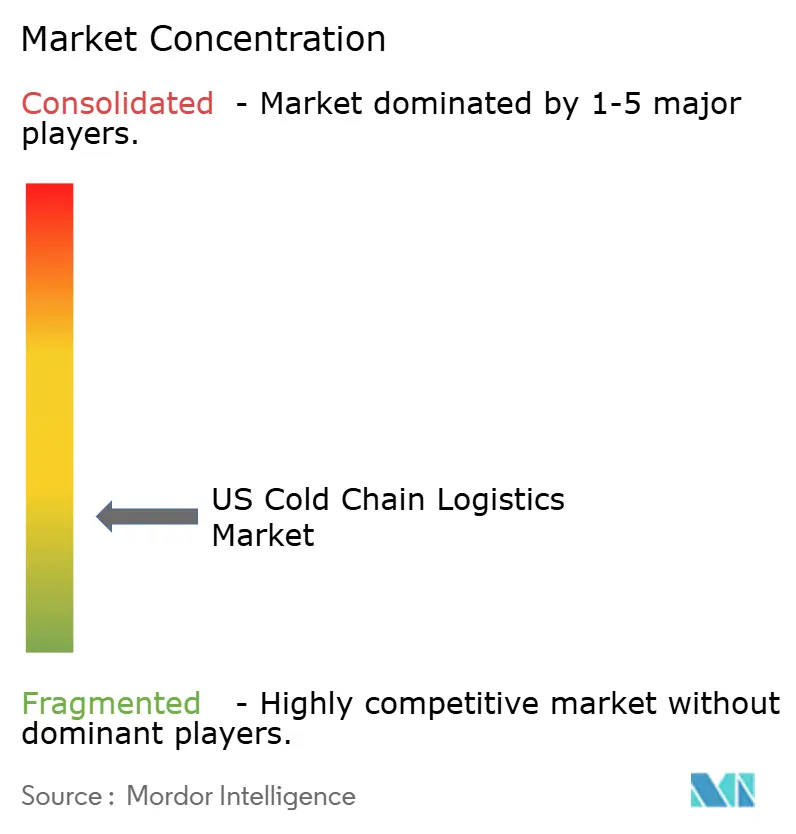
Recent Industry Developments
- April 2025: Lineage Logistics completed acquisition of Northeast Cold Storage, adding 15 million cubic feet in the Boston–New York corridor and expanding pharmaceutical capabilities.
- March 2025: Americold opened a fully automated 250,000-square-foot deep-freeze site in Dallas that runs on 100 % renewable power and uses AI for inventory slotting.
- February 2025: United States Cold Storage commissioned a Raleigh facility validated from -80 °C to +25 °C, positioning itself for emerging cell-and-gene therapy flows.
- January 2025: DHL Supply Chain launched a nationwide GDP-certified healthcare cold chain service covering both storage and over-the-road transport.
Research Methodology Framework and Report Scope
Market Definitions and Key Coverage
Mordor Intelligence defines the United States cold chain logistics market as the full spectrum of temperature-controlled storage and transportation services that keep perishable foods, pharmaceuticals, biologics, and specialty chemicals within their mandated temperature bands from the first point of consolidation through domestic distribution. The study tracks revenues generated by public and private refrigerated warehouses, refrigerated road, rail, sea, and air moves, and value-added services such as consolidation, blast-freezing, and repacking.
Scope exclusion: dry-ice courier parcels handled only within hospital campuses are outside our definition.
Segmentation Overview
- By Service Type
- Refrigerated Storage
- Public Warehousing
- Private Warehousing
- Refrigerated Transportation
- Road
- Rail
- Sea
- Air
- Value-Added Services
- Refrigerated Storage
- By Temperature Type
- Chilled (0–5 °C)
- Frozen (-18–0 °C)
- Ambient
- Deep-Frozen / Ultra-Low (More than 20 °C)
- By Application
- Fruits & Vegetables
- Meat & Poultry
- Fish & Seafood
- Dairy & Frozen Desserts
- Bakery & Confectionery
- Ready-to-Eat Meals
- Pharmaceuticals & Biologics
- Vaccines & Clinical Trial Materials
- Chemicals & Specialty Materials
- Other Perishables
- By Region (United States)
- Northeast
- Midwest
- Southeast
- Southwest
- West
Detailed Research Methodology and Data Validation
Primary Research
Semi-structured interviews with 3PL executives, grocery e-commerce managers, pharmaceutical supply-chain directors, and cold-warehouse developers across California, Texas, the Midwest, and the Northeast helped validate capacity utilizations, reefer rate inflation, and ASP progression assumptions. Follow-up surveys captured regional variance in biologics shipment volumes, enabling us to fine-tune temperature-mix splits.
Desk Research
Our analysts began with publicly available datasets, such as the USDA National Cold Storage Capacity survey, the FDA's FSMA compliance records, the Census Bureau Commodity Flow Survey, International Trade Administration import statistics, and industry briefs from the Food Marketing Institute. Annual reports and 10-Ks from major temperature-controlled logistics operators were mined for capacity builds, utilization, and average selling price trends, which are then cross-referenced in D&B Hoovers and Dow Jones Factiva for consistency. Academic journals covering refrigeration efficiency and perishables spoilage, along with patents flagged in Questel, provided additional demand signals for ultra-low-temperature infrastructure. This list is illustrative, not exhaustive; many other secondary sources aided data gathering and clarification.
Market-Sizing & Forecasting
A top-down demand-pool model reconstructs the tonnage and value of perishables produced domestically plus chilled and frozen imports, which are then allocated to storage and transport nodes using historic throughput ratios. Selective bottom-up checks, such as sampled pallet positions multiplied by average lease rates and major carrier reefer fleets multiplied by lane yields, calibrate totals. Key variables include cubic feet of public refrigerated space, e-grocery penetration, biologics NMEs in Phase III trials, diesel and electricity tariffs, and average outbound reefer spot rates. Forecasts employ a multivariate regression blended with scenario analysis to reflect shifts in e-commerce adoption and biologics approvals, while gap areas in bottom-up counts are bridged by conservative load-factor assumptions.
Data Validation & Update Cycle
Outputs pass variance screens against USDA inventory swings, FMCSA reefer-truck counts, and Bureau of Labor Statistics energy indices. Senior analysts review anomalies before sign-off. Reports refresh yearly, and material events trigger interim updates, ensuring clients always receive the freshest baseline.
Why Mordor's US Cold Chain Logistics Baseline Earns Decision-Maker Trust
Estimates published across the industry often diverge because firms differ on which services they count, the temperature ranges they include, and how frequently they refresh assumptions.
Key gap drivers span scope; some studies bundle dry ice parcel couriers or global monitoring devices, forecast stance; certain publishers apply double-digit growth uplifts from aggressive automation scenarios, and currency-conversion timing. Mordor anchors results to audited domestic capacity and verified perishables flow, applies measured ASP progressions, and refreshes figures each year, thereby avoiding outdated or inflated baselines.
Benchmark comparison
| Market Size | Anonymized source | Primary gap driver |
|---|---|---|
| USD 91.14 B | Mordor Intelligence | - |
| USD 83.9 B (2024) | Global Consultancy A | excludes ultra-low-temperature pharmaceutical moves |
| USD 109.5 B (2024) | Research Firm B | bundles Canada volumes and monitoring-device hardware sales |
| USD 34.67 B (2024) | Industry Study C | models only third-party revenue, omits captive in-house storage |
The comparison shows that once differing scopes and assumptions are isolated, Mordor's balanced, transparent approach supplies a dependable baseline that executives can trace back to clear variables and repeatable steps.
Key Questions Answered in the Report
What is the current US cold chain logistics market size?
The market stood at USD 91.14 billion in 2025 and is projected to reach USD 109.77 billion by 2030.
Which region holds the largest US cold chain logistics market share?
The Southeast leads with roughly one-third of national refrigerated capacity, supported by agricultural production and port access.
Which service segment is growing fastest in the US cold chain logistics industry?
Air transportation is forecast to post the highest CAGR, driven by time-critical pharmaceutical shipments.
Why is ultra-low-temperature capacity expanding so quickly?
Growth in cell-and-gene therapies and mRNA vaccines requires storage below -70 °C, prompting heavy investment in specialized freezers and cryogenic handling.
How are e-grocery trends affecting cold chain infrastructure?
Online grocery growth accelerates demand for micro-fulfillment centers and multi-zone delivery vehicles positioned close to urban consumers.
What policy incentives support energy-efficient cold storage construction?
The Inflation Reduction Act offers tax credits up to 30 % of qualifying costs for energy-saving upgrades, significantly shortening project payback periods.
